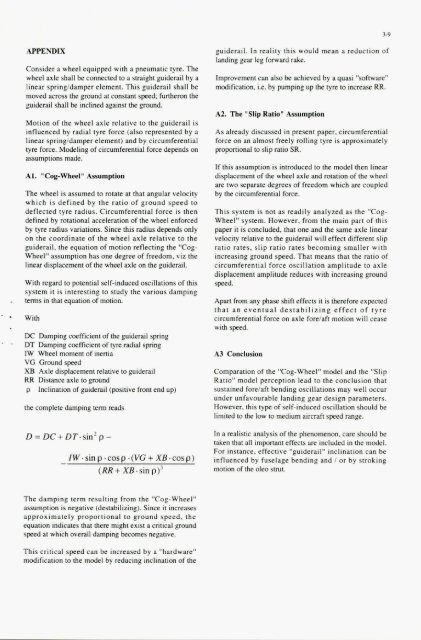AGARD R-800 - FTP Directory Listing - Nato
AGARD R-800 - FTP Directory Listing - Nato
AGARD R-800 - FTP Directory Listing - Nato
Create successful ePaper yourself
Turn your PDF publications into a flip-book with our unique Google optimized e-Paper software.
.<br />
. With<br />
APPENDIX<br />
Consider a wheel equipped with a pneumatic tyre. The<br />
wheel axle shall he connected to a straight guiderail by a<br />
linear springidamper element. This guiderail shall be<br />
moved across the ground at constant speed; funheron the<br />
guiderail shall be inclined against the ground.<br />
Motion of the wheel axle relative to the guiderail is<br />
influenced by radial tyre force (also represented by a<br />
linear springidamper element) and by circumferential<br />
tyre force. Modeling of circumferential force depends on<br />
assumptions made.<br />
Al. "Cog-Wheel" Assumption<br />
The wheel is assumed to rotate at that angular velocity<br />
which is defined by the ratio of ground speed to<br />
deflected tyre radius. Circumferential force is then<br />
defined by rotational acceleration of the wheel enforced<br />
by tyre radius variations. Since this radius depends only<br />
on the coordinate of the wheel axle relative to the<br />
guiderail, the equation of motion reflecting the "Cog-<br />
Wheel" assumption has one degree of freedom. viz the<br />
linear displacement of the wheel axle on the guiderail.<br />
With regard to potential self-induced oscillations of this<br />
system it is interesting to study the various damping<br />
terns in that equation of motion.<br />
DC Damping coefficient of the guiderail spring<br />
DT Damping coefficient of tyre radial spring<br />
W Wheel moment of inertia<br />
VG Ground speed<br />
XB Axle displacement relative to guiderail<br />
RR Distance axle to ground<br />
p Inclination of guiderail (positive front end up)<br />
the complete damping term reads<br />
-<br />
IW. sin p .cosp .(VG + XB .cosp)<br />
(RR+XB.sinp)'<br />
The damping term resulting from the "Cog-Wheel"<br />
assumption is negative (destabilizing). Since it increases<br />
approximately proportional to ground speed, the<br />
equation indicates that there might exist a critical ground<br />
speed at which overall damping becomes negative.<br />
This critical speed can he increased by a "hardware"<br />
modification to the model by reducing inclination of the<br />
guiderail. reality this woul<br />
landing gear leg forward rake.<br />
3-9<br />
nean a reduction of<br />
Improvement can also be achieved by a quasi "software"<br />
modification. i.e. by pumping up the tyre to increase RR.<br />
AZ. The "Slip Ratio" Assumption<br />
As already discussed in present paper, circumferential<br />
force on an almost freely rolling tyre is approximately<br />
proportional to slip ratio SR.<br />
If this assumption is introduced to the model then linear<br />
displacement of the wheel axle and rotation of the wheel<br />
are two separate degrees of freedom which are coupled<br />
by the circumferential force.<br />
This system is not as readily analyzed as the "Cog-<br />
Wheel" system. However, from the main part of this<br />
paper it is concluded, that one and the same axle linear<br />
velocity relative to the guiderail will effect different slip<br />
ratio rates, slip ratio rates becoming smaller with<br />
increasing ground speed. That means that the ratio of<br />
circumferential force oscillation amplitude to axle<br />
displacement amplitude reduces with increasing ground<br />
speed.<br />
Apan from any phase shift effects it is therefore expected<br />
that an eventual destabilizing effect of tyre<br />
circumferential force on axle foreiaft motion will cease<br />
with speed.<br />
A3 Conclusion<br />
Comparation of the "Cog-Wheel" model and the "Slip<br />
Ratio" model perception lead to the conclusion that<br />
sustained foreiaft bending oscillations may well occur<br />
under unfavourable landing gear design parameters.<br />
However. this type of self-induced oscillation should be<br />
limited to the low to medium aircraft speed range.<br />
In a realistic analysis of the phenomenon, care should be<br />
taken that all important effects are included in the model.<br />
For instance, effective "guiderail" inclination can be<br />
influenced by fuselage bending and / or by stroking<br />
motion of the oleo strut.

















